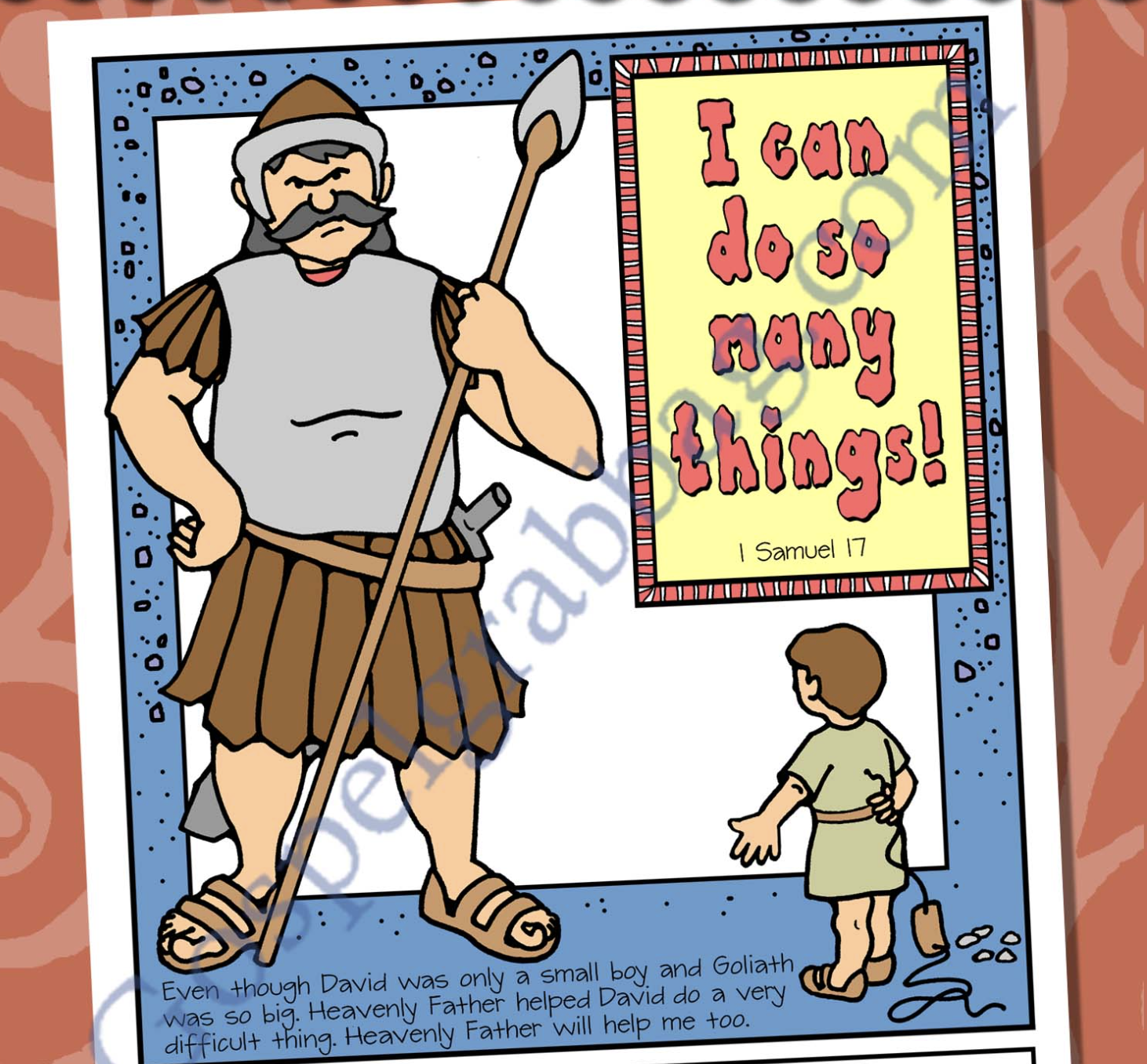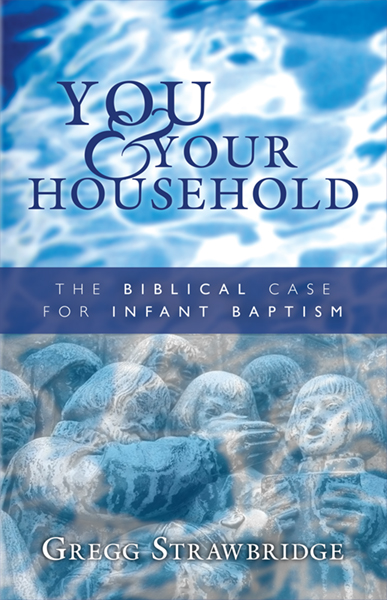Last week, our church hosted a Vacation Bible School that included the story of “David and Goliath” as one of the Bible stories. I was responsible for the “Bible story station” that introduced the characters, the meaning behind the story, and its application. Groups would spend twenty minutes with me and then return later in the day for ten minutes of reflection and prayer.

Our VBS theme’s package included scripted lessons that a leader could simply read with sample questions and ideas for applications for various age groups. Our materials were produced by the Methodist publisher Cokesbury and generally faithful to the Biblical story. They were also insightful about how to manage the attention of younger students, but like all modern children’s curricula – do not expect much from the child.
On Bite-Sized Lessons
Exercises like this always cause me to question how much of Sunday’s sermon is actually understood by my youngest congregants. The VBS curriculums seem to assume that children need everything delivered in such easily digested, bite-sized pieces. Perhaps this level of VBS is meant for children who may have never been to a church. But not even two minutes into my introduction of David and Goliath it was obvious that my group of eight and nine-year-olds were already very familiar with the details of the story—down to the number of stones that David collects. The study guide wanted me to focus on “facing bullies” and “overcoming adversity” but the kids had heard it all before.
Caught off guard, I went into “Rev. Clowney Mode” and thought I would pivot into teaching how Goliath’s downfall points to Christ. Now completely off script, I asked the students, “So what happened to Goliath next?” A few hands went up. One young man was so excited to share that I decided to ignore his impatient “I know! I know!” and call on him anyway. “David cut his head off!” For some strange reason, this scene wasn’t included in the coloring sheets and didn’t make it into any of the suggested drama skits for the day. Go figure.
And, “and then what happened?” I asked. The students looked at each other, shrugged, and back to me. Here I explained that King David eventually took the giant’s skull to Jerusalem, to be buried just outside of the Holy City of Jerusalem.
I asked them to consider Goliath a type of serpent, reminding them that “coat of mail” that we see described as his armor in 1 Samuel 17 is more akin to a breastplate of snake scales. I then asked them to remember the Garden of Eden and to consider the promises made to Adam and Eve after their expulsion, chiefly that a descendent of theirs was to crush the head of the serpent. I pointed out that in our Scripture reading, David’s stone “sunk” into Goliath’s head. David was Adam’s great-great (times thirty-five generations) grandson and he was well aware of the promises to his family’s line. He and all future generations would remember David as the son of Adam who had crushed the serpent with a stone to the head.
Yet David was only fulfilling part of that promise. David’s battle with Goliath was looking forward to when the Messiah would destroy the true serpent and undo mankind’s death curse. David anticipated this when he brought Goliath’s skull back to Jerusalem as a covenant sign of God’s future faithfulness. For the very place that David buries Goliath’s skull is to become the very same spot that Jesus is to be crucified: Golgotha.

As James B. Jordan points out:
“Golgotha is just a contraction of Goliath of Gath (Hebrew: Goliath-Gath). 1 Samuel 17:54 says that David took the head of Goliath to Jerusalem, but since Jerusalem was to be a holy city, this dead corpse would not have been set up inside the city, but someplace outside. The Mount of Olives was right in front of the city (1 Kings 11:7; 2 Kings 23:13), and a place of ready access. Jesus was crucified at the place where Goliath’s head had been exhibited. Even as His foot was bruised, He was crushing the giant’s head!”
Biblical Horizons Newsletter No. 84: Christ in the Holy of Holies The Meaning of the Mount of Olives by James B. Jordan (April, 1996)
I had gone way off course from the VBS script. I was talking about burying a giant’s skull and Christ crucified, where the script had this as its closing reflection: “If you wonder how you can face challenges that might seem bigger than you, remember that with God you can find what you need to help you meet your challenges.”

At reflection time they returned eager for more juicy details about David’s bloodlust, only for me to remind them of Christ’s present promises to conquer sin and that perhaps us miserable sinners are more like Goliath than David in the story. We deserve a stone to the head for our life of war against God. And like Goliath’s lifeless skull outside of Jerusalem, our only hope was the blood dripping down from the saviour on the cross.
On Practical, Relevant Preaching
The need for a “practical application” and the lure of relevance or accessibility has detached the Christian meaning of David versus Goliath from its place in the story of the Gospel. King David as a historical figure with a natural and spiritual lineage leading to Jesus is of no real consequence in the VBS version. While I have no doubt that this story also presents a great opportunity for character building in giving us examples of overcoming adversity, let’s not limit David to the realm of mere fable.
After all, popular authors have done much better than pastors with this self-help approach. For example, Malcom Gladwell parlayed the underdog notion of David and Goliath into a New York Times Bestseller back in 2015 when he connected this story to all sorts of character applications. Everything from the religious sacrifices of the French Huguenots to the jumbled but noble struggle of dyslexics. In Gladwell’s applications, the whole idea of the story was simple: what we saw as disadvantages in the small-statured shepherd boy, were actually his secret weapons against the Philistine giant. David had it in him the whole time, everyone else just couldn’t see it. Is this the message of Christ?
We must contend that the Holy Spirit did not include the battle with Goliath to add a Hebrew hero to the Aesopica. David’s battle must be more than a story for inspiring courage and spurring on self-development. We have not faithfully taught any passage of Scripture without connecting it to the story of Christ’s redemption. Or as Rev. Edmund Clowney put it, “Preachers who ignore the history of redemption in the preaching are ignoring the witness of the Holy Spirit to Jesus in all the Scriptures.”

Esoteric Speculations
Grounding our teaching in the story of Christ also prevents the fetishizing of obscure details in the Hebrew text. I was recently asked to lead a book study through Michael S. Heiser’s book The Unseen Realm. While leading the study, I quickly learned that the generation of men taught under “relevant preaching” styles had missed out on the necessary theological framework to hang the Old Testament narratives. They craved the order and structure The Unseen Realm offers. Unfortunately, Heiser’s book reads like he has just recently unlocked a secret code to understand the Bible through special ancient symbols and obscure language clues.
Speculations about Nephilim, angels, and giants creep in and have the power to wedge an artificial gap between our historical theology and our new pet passages. Men like Othmar Keel, Meredith Kline, and Gregory Beale have been offering us similar approaches to Biblical symbolism while staying within Nicene orthodoxy and the historic church. And of course, James Jordan offered a very accessible compendium of Biblical symbolism in his book Through New Eyes.
How much did Goliath’s armor weigh? Were his ancestors fallen angels? Did the giants survive the flood? Does new Philistine DNA evidence prove the existence of bronze-age giants? The depths of the Biblical text are inexhaustible, or as D.A. Carson put it in his book The Gospel as Center, “The Bible is an ever-flowing fountain…” but wild speculations detached from the story of salvation are not equal to seeing Christ in every passage of Scripture. To see Christ in every God-breathed passage is to drink from the living stream, while a desire for obscurity inevitably leads to the brackish waters of pseudo-scholarship based in the mysteries of pseudepigraphon and cliches of post-modern religious studies.
Teach Christ
There’s nothing foolish, redundant, or mediocre about Christ-centered preaching. Those who love the Lord will never tire of hearing how Christ is present on every page. Those who are far from him desperately need to hear him speak to every area of life. Let us never grow weary in taking captive every thought to make it obedient to Christ. (2 Corinthians 10:5)

















Why did David want to take Goliath’s head to Jerusalem?
Everyone knows the story of David and Goliath, however many are not aware of what happened next.
1 Samuel 17:53-54 “And the people of Israel came back from chasing the Philistines, and they plundered their camp. 54 And David took the head of the Philistine and brought it to Jerusalem, but he put his armor in his tent.”
Now the battle between David and Goliath took place in the Valley of Kayla, which was almost 20 miles from Jerusalem. Why would David carry Goliath’s head all the way to Jerusalem, and what did he do with it when he got there?
It was a common practice for a king to decapitate the head of his enemy, and then stick it on a pole high on a hill, where many people could see it. The fact that David brought Goliath’s head to Jerusalem was quite an astonishing fulfillment of an ancient prophecy. But where in Jerusalem did David take Goliath’s head?
One clue is a link between the name Goliath of Gath, and Golgotha. The name of Goliath of Gath is a name derived from the two words “Gola Gatha.” One can say fairly confidently, that David took the head of Goliath (the head of the serpent), and put it on the end of a pole, and lifted the pole high up in the air for all to see. And after the birds had picked off all the flesh; He buried the skull on the top of a hill in Jerusalem, a place called Golgotha, still known today as “the place of the skull.”
“And the Philistine said to David; Come to me and I will give they flesh unto the fowls of the air, and to the beasts of the field. Then said David to the Philistine; Thou comest to me with a sword, and with a spear, and with a shield, but I come to thee in the name of the Lord of hosts, the God of the armies of Israel, whom thou hast defied. This day will the Lord deliver thee into mine hand; and I will smite thee, and take thine head from thee; and I will give the carcases of the host of the Philistines this day unto the fowls of the air, and to the wild beast of the earth; that all the earth may know that there is a God in Israel. And all the assembly shall know that the Lord saves not with sword and spear; for the battle is the Lord’s, and he will give you into our hands.”
“And it came to pass, when the Philistine arose and came to draw nigh to meet David, that David hastened, and ran toward the army to meet the Philistine. And David put his hand in his bag, and took thence a stone, and slang it and smote the Philistine in his forehead, that the stone sunk into his forehead; and he fell upon his face to the earth. So David prevailed over the Philistine with a sling and with a stone, and smote the Philistine, and slew him; but there was no sword in the hand of David. Therefore David ran, and stood upon the Philistine, and took his sword, and drew it out of the sheath thereof, and slew him, and cut off his head therewith. And when the Philistines saw their champion was dead, they fled.
And the men of Israel and of Judah arose and shouted, and pursued the Philistines, until thou came to the valley, and to the gates of Ekron. And the wounded of the Philistines fell down by the way to Shaaraim, even unto Gath and unto Ekron. And the children of Israel returned from chasing after the Philistines, and they spoiled their tents. And David took the head of the Philistine and brought it to Jerusalem; but he put his armor in his tent.”
When David took Goliath’s head back to Jerusalem it would have been considered unclean and against Jewish law to bring a stinking rotting head into the city. The head had to be buried somewhere outside of the city, as gentiles (non Jews) were considered unclean. The head of Goliath was a trophy of war and would have been displayed on a high hill just outside of the city gates, overlooking Jerusalem, so that God’s people could look up and see God’s enemy has been vanquished.
David is a type of Christ. His prophetic victory over Goliath in battle is similar to the crushing death-blow that Jesus would give to the devil 600 years later in the future when He would die on the cross at Golgotha.
David killed Goliath with one stone. This stone is a symbol of one of God’s greatest commandments, called the golden rule. “Love your neighbor as you love yourself. Care about your neighbor as you care about yourself.” If you keep this one commandment you’ve kept them all. And Love is the power that destroys all evil.
And the angel said unto her, Fear not, Mary: for thou hast found favor with God. And, behold, thou shalt conceive in thy womb, and bring forth a Son, and shall call His Name JESUS. He shall be great, and shall be called the Son of the Highest: and the Lord God shall give unto Him the throne of His father David: And He shall reign over the house of Jacob forever; and of His kingdom there shall be no end.
Then said Mary unto the angel, How shall this be, seeing I know not a man? And the angel answered and said unto her, The Holy Ghost shall come upon thee, and the power of the Highest shall overshadow thee: therefore also That Holy Thing Which shall be born of thee shall be called the Son of God.“
Goliath was one of the giants which were born as a result of the fallen angles having sex with the earthly women. Goliath, who was of the Lineage of Cain, was ⅔’s angel and 1/3rd human, and was a genetic mutation of God’s perfect creation of man, whom He had made in the image and likeness of himself. Goliath represented pure evil, the “seed (children) of the serpent.” He was one of the super soldiers that the devil and his fallen angels had sired, to totally destroy God’s lineage (seed) from off the face of the earth, so that the promissed Messiah would never come.
God has recently revealed that the Ark of the Covenant was hidden in a cave directly below the crucifix of the Messiah, the King of the Jews. At the moment Jesus gave up the Ghost, the earth shook violently, and the ground cracked open, and the blood from Jesus’ wounds flowed downward his legs and feet and into the cross hole, and dripping on to the Mercy Set of the Ark of the Covenant, that God the Father had told Jeremiah to hid there 600 years before Christ died on the cross.
JESUS WAS “THE LAMB SLAIN FROM THE FOUNDATION OF THE WORLD
Thus fulfilling the prophecy that Jesus was the lamb slain before God laid the foundations of the earth. He was the Messiah, the promised seed of Eve’s that would be pierced in the heel, while crushing the head of Satan. Genesis 3:15 “And I will put enmity between thee and the woman, and between thy seed and her seed; It shall bruise thy head and thou shalt bruise his heel.”
God declared his promise: that from Eve would come a Seed who would bruise (break) the head of the serpent, and the serpent shall bruise (break) his heel.
Goliath was a giant super soldier that would come out every day and mocked God. He had a helmet of brass, and a coat of mail made of five thousand shekels of brass rings. And he had shields of brass upon his legs, and a breastplate of brass between his shoulders. (1 Samuel 17:5,6).
This might cause a light to go on in your head. Because, the word for bronze, nehoshet, sounds similar to the word for serpent, nehesh. Brass looks like gold when it’s shiny, but when it starts to weather and gets tarnished, it starts to show its true color, a slimy green, like the scales of a snake or fish.
“Then the Lord said to Moses, ‘Make thee a fiery serpent and set it on a pole. And it shall come to pass, that everyone that is bitten, when he looks upon it, shall live.’ So Moses made a serpent of brass and put it on a pole. And it came to pass, that if a serpent had bitten any man, when he beheld the serpent of brass, he lived. ” -Numbers 21:8-9
“Just as Moses lifted up the serpent in the wilderness, even so must the Son of Man be lifted up; that whosoever believes in Him should not perish, but have eternal life.” -John 3:14-15
This battle was not merely about Philistines and Israelites; it was about who would rule over heaven and earth: the Serpent or YHWH! And now comes David, not with Serpent armor or weapons but with powerful declarations: “this day YHWH will deliver you into my hand, and I will strike you down and cut off your head” (1 Samuel 17:46).
David, like Moses, put the head of the serpent on a pole and raised it up high in the air for all to see; And as many as have sinned, (been bitten by the deadly serpent, shall die); For the penalty of sin is death. But if we repent of our sins, and ask God to forgive us, and believe in what Jesus’ sacrifice on the cross and the sprinkling of His blood on the mercy seat has done for us, we shall be saved.
For more information see:arkofthecovenant2.blogspot.com – Kevin Quinn
The serpent in Samuel could also be interpreted as a picture of Christ taking down depression. Goliath is the uncircumcised “exposed” one. At 6 cubits, he is the fullest expression of a humanistic giant. The battle takes place in the valley of blood. The philistine, which means immigrant or one who dwells in the dust, is the fullest example of the curse of the serpent in Genesis 3. The root word of “pilisti” is “palas” which occurs four times in the prophets to signify deep despair, anxiety and woe, in the context of one rolling in dust as if he were a corpse. The philistine is also the descendant of Ham, who likely committed some sort of sexual indecency while Noah re enacted a new kind of fall by getting drunk as a farmer rather than tending the garden. These are the two preconditions for the fallen demons to make their re entry into the physical world. Altered states of consciousness and sexual perversion are the two primary vehicles that create chaos in our world as Psalm 82 accuses the “gods” of doing.
David cannot wear Saul’s armour no more than we can wear someone else’s armour when we engage in spiritual warfare. The philistine mocks the armies of Israel, incidentally whom David associates with the armies of God. David, as a youth, goes to attack the serpent, running to meet Him in the valley. Valleys are important because they symbolize trials and tribulations. But it’s always in the valleys where the water gathers to form streams and rivers symbolized by the Holy Spirit. And that is in fact where David takes his weapons of warfare from. Five smooth or perfect stones are taken from the middle of the stream. They are soaked in the water of the Holy Spirit. Five stones are taken, one for each of the five kings/cities of the philistines , but also for the five senses by which we encounter our world in order to engage in spiritual warfare – particularly our eyes since much is made about the appearance of Goliath. Each of the stones represent Christ, much as the rock that followed the Israelites though the wilderness providing water for the Israelites was Christ according to Paul.
The rock is slung as David runs to attack the giant. But notice what his weapon of warfare is. It’s a sling. We know that this was a weapon of pinpoint accuracy. Benjaminites could sling stone with both the right and left hands and split hairs. David takes the same sling a takes the stone (Christ) as it travels straight into the forehead and sinks in deeply as the giant falls to the ground. In Jewish thought, the forehead is representative the seat of one’s thoughts. They would place phylacteries in little boxes on their heads so that torah would always be at the forefront of their thoughts. The stone which is Christ is taken to the center of how the serpent thinks. Just as the serpent deceived Eve in her thoughts, so we must take every though captive to Christ to tear down the serpent which symbolizes not just depression, but every other stronghold that sets itself up in opposition to Christ. That stone which is Christ takes the serpent down. We can not entertain one aspect of the serpents thinking. Taking the mind of Christ to the serpent causes him to crash to the ground, but that only causes the crash. We have to take the sword of the Spirit which is the Word of God and cut off its head for good, and bury it outside of Jerusalem, where the wooden tent peg of the cross penetrates the skull once and for all, and slays the serpent just as Jael took a wooden tent peg to Sssssissssera the serpent’s temple.
The further a society moves away from the truth of God, the more the bold the Goliaths of our age(mental health and sexual perversion) rise up and mock us. The Philistines are once again raiding the land.